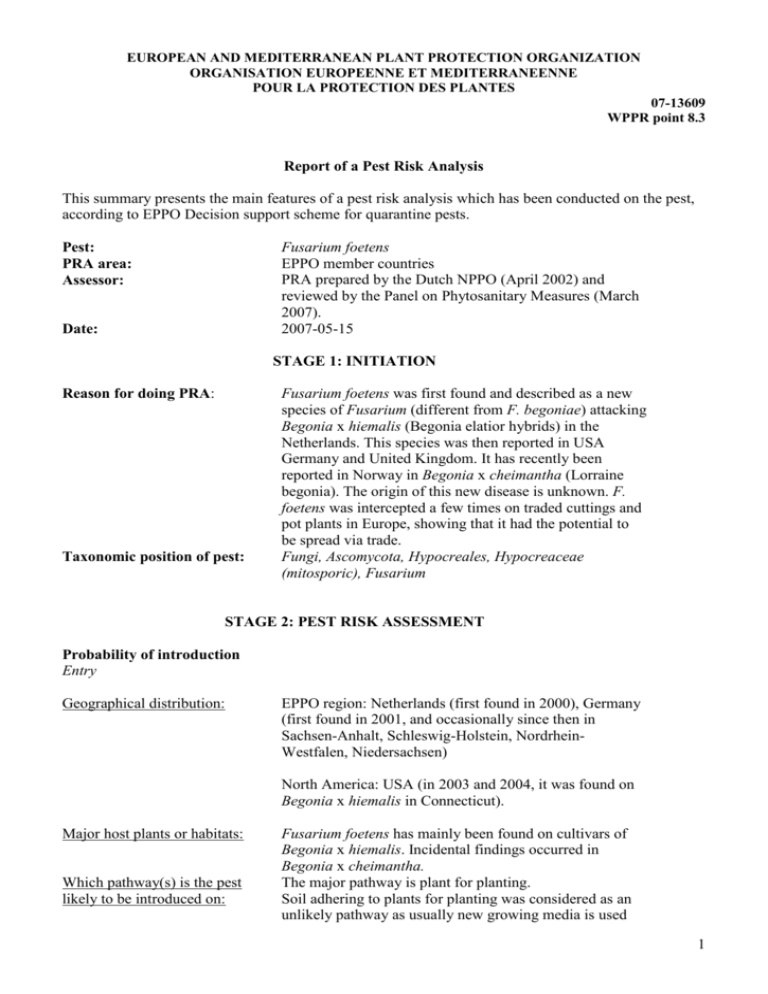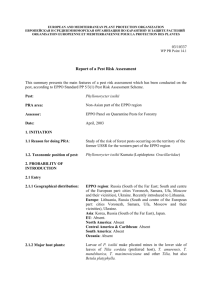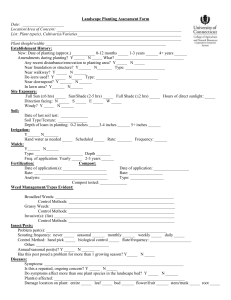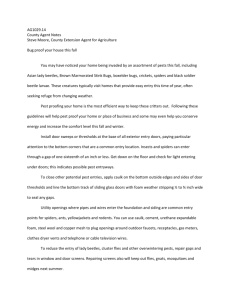european and mediterranean plant protection organization
advertisement

EUROPEAN AND MEDITERRANEAN PLANT PROTECTION ORGANIZATION ORGANISATION EUROPEENNE ET MEDITERRANEENNE POUR LA PROTECTION DES PLANTES 07-13609 WPPR point 8.3 Report of a Pest Risk Analysis This summary presents the main features of a pest risk analysis which has been conducted on the pest, according to EPPO Decision support scheme for quarantine pests. Fusarium foetens EPPO member countries PRA prepared by the Dutch NPPO (April 2002) and reviewed by the Panel on Phytosanitary Measures (March 2007). 2007-05-15 Pest: PRA area: Assessor: Date: STAGE 1: INITIATION Reason for doing PRA: Taxonomic position of pest: Fusarium foetens was first found and described as a new species of Fusarium (different from F. begoniae) attacking Begonia x hiemalis (Begonia elatior hybrids) in the Netherlands. This species was then reported in USA Germany and United Kingdom. It has recently been reported in Norway in Begonia x cheimantha (Lorraine begonia). The origin of this new disease is unknown. F. foetens was intercepted a few times on traded cuttings and pot plants in Europe, showing that it had the potential to be spread via trade. Fungi, Ascomycota, Hypocreales, Hypocreaceae (mitosporic), Fusarium STAGE 2: PEST RISK ASSESSMENT Probability of introduction Entry Geographical distribution: EPPO region: Netherlands (first found in 2000), Germany (first found in 2001, and occasionally since then in Sachsen-Anhalt, Schleswig-Holstein, NordrheinWestfalen, Niedersachsen) North America: USA (in 2003 and 2004, it was found on Begonia x hiemalis in Connecticut). Major host plants or habitats: Which pathway(s) is the pest likely to be introduced on: Fusarium foetens has mainly been found on cultivars of Begonia x hiemalis. Incidental findings occurred in Begonia x cheimantha. The major pathway is plant for planting. Soil adhering to plants for planting was considered as an unlikely pathway as usually new growing media is used 1 when cuttings are introduced in a production unit. Natural spread was also considered unlikely. Establishment Plants or habitats at risk in the PRA area: Climatic similarity of present distribution with PRA area (or parts thereof): Protected cultivation of mainly Begonia x hiemalis (Begonia elatior hybrids) and to a much lesser extend Begonia x cheimantha (Lorraine begonia). Outbreaks have been recorded in glasshouses. The origin of the pest is not known. Climatic comparison is difficult. Aspects of the pest's biology that Survival of chlamydospores of Fusarium species in would favour establishment: greenhouse conditions is likely due to a favourable temperature and moisture regime. It can also establish in water systems used for irrigation purposes. Characteristics (other than Begonia is commonly cultivated in the PRA area in greenclimatic) of the PRA area that houses. Recirculation of water used at production places would favour establishment: for propagation could favour the establishment of the pest. Which part of the PRA area is the Begonia x hiemalis (Begonia elatior hybrids) is cultivated endangered area: in green-houses in all major ornamental plant producing countries of the EPPO region. POTENTIAL ECONOMIC CONSEQUENCES In nurseries where is was detected, the disease was How much economic impact does the pest have in its present reported as severe and mortality of plants has been observed. The disease could not be easily controlled. distribution: 100 % losses were recorded on Begonia elatior under experimental conditions in glasshouse at the Plant Protection Service. Losses caused by the formae speciales of the closely related fungus Fusarium oxysporum are usually high and their control is difficult in practice (it relies on a combination of various methods, such as chemical control disinfection and hygiene measures). Data on economic impact result from few outbreaks and companies producing Begonia are only a few. Nevertheless for these specialised companies economic impact was high. 2 Describe damage to potential hosts in PRA area: Diseased plants showed basal rot, vein yellowing and wilting. Large macroconidial masses formed by the fungus covered the base of collapsing begonias. Economic impact has already been recorded in the PRA How much economic impact would the pest have in the PRA area. Begonia elatior production is at risk. area: CONCLUSIONS OF PEST RISK ASSESSMENT Outbreaks have already been recorded in the EPPO region Summarize the major factors that influence the acceptability and economic impact was high in the companies concerned. of the risk from this pest: Estimate the probability of entry: Estimate the probability of establishment: The probability of entry is high (it has already entered the EPPO region and is also recorded in the US. Establishment potential is high. Estimate the potential economic impact: Economic impact potential is considered high, based on observations in outbreak situations in the EPPO region.. Degree of uncertainty Geographical distribution and origin of the pest. Data is lacking on the host range (Brand & Wienberg, 2005). OVERALL CONCLUSIONS The pest presents a risk for the Begonia production in the EPPO region. 3 STAGE 3: PEST RISK MANAGEMENT IDENTIFICATION OF THE PATHWAYS Plants for planting of Begonia x hiemalis and Begonia x Pathways studied in the pest cheimantha risk management Other pathways identified but Soil attached to plants Natural spread not studied IDENTIFICATION OF POSSIBLE MEASURES Possible measures for pathways Measures related to consignments: Visual inspection of consignments is not reliable, as at an early stage F. foetens is difficult to detect Testing of consignments is possible but not practical on a systematic basis Infestation of the consignment may be prevented by the production of the plants for planting in a certification scheme but this would need to be combined with measures for ensuring exclusion and may be one of the conditions for establishing a place of production freedom (see below). Measures related to the crop or to places of production: Pest-free area Pest-free place of production Other possible measures In case of outbreaks, measures aiming at eradication should be implemented. This includes the destruction of all potentially infected plants, restriction of movement of plant material. An additional measure for controlling pathways within production places is the prohibition of recirculation of water used at production places for propagation of of Begonia x hiemalis and Begonia x cheimantha unless adequate treatment can be guaranteed. EVALUATION OF THE MEASURES IDENTIFIED IN RELATION TO THE RISKS PRESENTED BY THE PATHWAYS Degree of uncertainty CONCLUSION: Recommendation for possible measures (type presentation): Plants for planting of Begonia x hiemalis and PC and, if appropriate, RC Begonia x cheimantha originating in countries where Fusarium foetens occurs Pest-free area for Fusarium foetens or Place of production freedom for Fusarium foetens. 4







